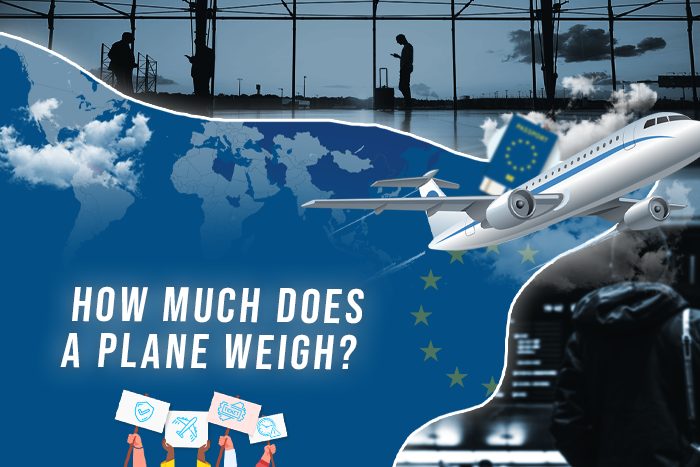Planes are fantastic pieces of technology that have made traveling worldwide easier for more than 100 years. We’ve come a long way from these early designs. The Wright Brothers 1903 plane weighed just 605 pounds.
Now, commercial planes carry more than that in luggage alone! Typically, the average commercial aircraft will weigh between 152.9 and 220.1 tons – or 337,100 to 485,300 pounds. That is just the weight of the plane alone. It gets even heavier when you add the people, luggage, and other materials transported on planes. But there are maximums that planes need to stay under to maintain their flight worthiness. Any higher, and the plane will be unable to take off.
The answer to how much a plane weighs is complicated, so let’s dig deeper to understand why.
Key Takeaways
- Planes have two types of weight: the empty operating weight (EOW) and the maximum take-off weight (MTOW). The EOW is how much the plane weighs on its own, while the MTOW is how heavy the plane can be once fully loaded to take off.
- The average weight of a commercial plane alone is between 152.9 and 220.1 tons or 337,100 to 485,300 pounds. However, this weight increases significantly when passengers, cargo, and fuel are added.
- Different types of planes have varying weights, with personal airplanes weighing between 740 and 2,750 pounds, fighter jets weighing between 20,300 and 45,000 pounds, and helicopters weighing between 275 and 56,000 kilograms.
- The weight of a plane affects its fuel efficiency and environmental impact, as heavier planes consume more fuel and emit more emissions.
- It’s important to identify the specific model of a plane and its weight limits before flying, as exceeding the MTOW can make it impossible for the plane to take off.
Type Of Weight
Planes have two different types that are measured: the empty operating weight and the maximum take-off weight. The empty operating weight (EOW) is how much the plane weighs on its own. This doesn’t include the fuel it needs to get to its destination, passengers, cargo, food, and other incidentals. The EOW is simply how much the plane weighs itself.
Now the maximum take-off weight (MTOW) is everything else. This is how heavy the plane can be once fully loaded to take off. If the MTOW is exceeded, the plane will not be able to fly, so if you’ve ever been kicked off a flight because the flight was too heavy, this is why. The average MTOW for a commercial plane is between 320 and 447.7 tons or 700,000 and 987,000 pounds.
Interestingly, the plane will change weight as it flies, so what it weighed as you took off isn’t what you’ll weigh as you land. Fuel weighs a lot, so the plane will weigh less as you burn through it. Unfortunately, this doesn’t help the MTOW if it is exceeded.
The bigger the plane, the more it will weigh, both EOW and MTOW.
Different Types Of Planes

We’ve already talked about commercial planes, but how much do other types of planes weigh? The same principles apply. They still have an EOW and MTOW, but they’re often at much lower thresholds.
Depending on the size, personal airplanes typically weigh between 740 and 2,750 pounds. They typically hold only a few passengers with little to no luggage, only used for short-range flights. Depending on the type, model, and size, they could have an MTOW of up to 5,670 kilograms, but it’s important to check your needs before flying.
Fighter jets weigh between 20,300 and 45,000 pounds, and their MTOW can range between 4,800 kg and 640,000 kg, depending on the type, size, and model. These planes are often equipped with heavy technologies, so often, half of their MTOW is taken up by the plane alone. That’s even more interesting when you consider that fighter jets typically only sit one to two people!
Helicopters typically weigh between 275 and 56,000 kilograms, depending on the size and model. They can come in ultralight to heavy models, impacting how much weight it can hold. Typically, the MTOW will be between 1,560 and 5,670 kilograms.
The Final Word On Plane Weight
How much your plane weighs depends on the size and model, as well as the materials it was made of, what’s in the plane, and more. The plane itself can have a weight (EOW), but it does not include any useful materials like fuel or personnel that would help it fly. If you’re interested in how much your flight weighs, identify the plane model and look it up!
Frequently Asked Questions
-
What is the average weight of a commercial plane?
The average weight of a commercial plane alone is between 152.9 and 220.1 tons, or 337,100 to 485,300 pounds. However, this weight increases significantly when passengers, cargo, and fuel are added.
-
What is the difference between the empty operating weight and the maximum take-off weight of a plane?
The empty operating weight (EOW) is how much the plane weighs on its own, while the maximum take-off weight (MTOW) is how heavy the plane can be once fully loaded to take off.
-
How does a plane’s weight affect its fuel efficiency and environmental impact?
The weight of a plane affects its fuel efficiency and environmental impact, as heavier planes consume more fuel and emit more emissions.
-
What is the weight range of personal airplanes?
Personal airplanes typically weigh between 740 and 2,750 pounds, depending on the size and model.
-
What is the weight range of fighter jets?
Fighter jets typically weigh between 20,300 and 45,000 pounds, depending on the type, size, and model.
-
What is the weight range of helicopters?
Helicopters typically weigh between 275 and 56,000 kilograms, depending on the size and model.







